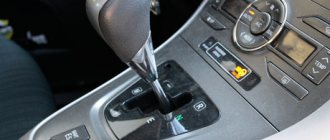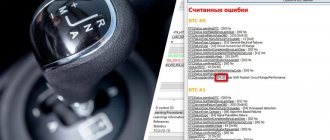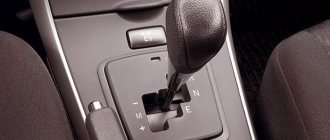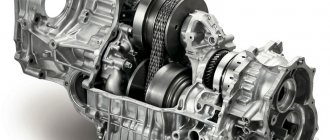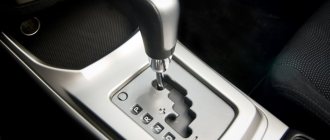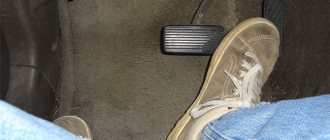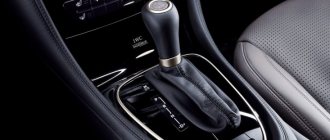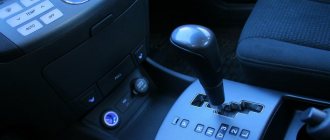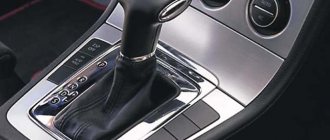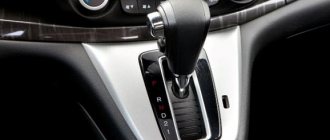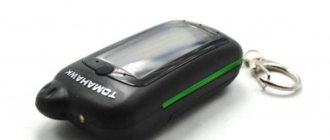Passenger cars use several types of stepped transmissions that provide manual or automatic gear shifting. On some cars there is a robotic gearbox, created on the basis of a mechanical one, but with automatic gear shifting and clutch control. The driver needs to know how to drive a robot, since the life of the clutch and the mechanical part of the gearbox depends on proper operation.
Robotic gearboxes are quite popular these days.
A little about the device
The essence of such a box is quite simple - there is a manual gearbox and an electronic control unit for it. With a manual transmission, all the functions that a driver with a manual transmission had to perform (squeezing the clutch, moving the gearbox lever to the desired position) are performed by actuators - servos of the electronic unit.
Thanks to this, the reliability of the gearbox has increased due to the use of classical “mechanics” and the ease of use has increased. The driver just needs to move the selector to the desired position (as in an automatic transmission) and enjoy the ride, and the electronic unit will take care of the gear shift.
With all this, many robotic boxes are also equipped with manual controls, which allows the driver to control the box independently, with the only difference - there is no need to squeeze the clutch.
Control Features
The manual transmission received some operating modes from the automatic transmission, namely:
- "N" - neutral. A mode in which torque is not transmitted to the wheels from the gearbox. That is, the engine is running, rotation is transmitted to the box, but due to the position of the gears, it is not transmitted to the wheels. Used when parking a car for a long time, before starting to move, after stopping;
- "R" - reverse movement. Everything is simple here, the driver moves the selector to this position and the car moves backwards.
Other modes of the robotic box have their own designation:
- "A/M" or "E/M" - forward movement. This mode corresponds to the “D” mode of an automatic transmission, that is, the car moves forward and the gearbox changes gears. In “M” mode manual control is performed. By moving the selector to a certain groove, the required mode is selected;
- “+”, “-” - gear switch. Short-term shifts of the selector to the “+” or “-” side ensure gear shifting in the “M” manual control mode.
Variable speed drive
The variator is characterized by smooth operation - there are no gears, and the torque is transmitted through a belt sliding along the cones and changing the ratio of their revolutions. The service life of variators is comparable to the service life of hydromechanical automatic machines. But CVTs do not like off-road conditions and slipping, they overheat and fail faster. Moreover, in the city such a gearbox is indispensable precisely because of the smooth operation due to the lack of switching.
| Pros: | Minuses: |
|
|
Is it necessary to warm up the box?
It seems that everything is simple, and there is nothing complicated in controlling such a box - just move the selector to the desired position and start moving. Still, you should know how to control the robot box so that it works without problems.
Let's start with an interesting question - is it necessary to warm up the gearbox before driving in winter? For an automatic transmission in winter, warming up is mandatory and is performed by briefly moving the selector to all positions.
The robotic gearbox is essentially mechanical and does not require warming up. And yet, in winter, the manual transmission should be warmed up before driving, although this is not exactly warming up. When parked, the oil in the box flows down and thickens due to frost. Therefore, it is recommended in winter, after starting the engine, to give time so that the oil does not warm up, but simply spreads over the elements of the box, reducing friction between them. It’s enough to just stand for a couple of minutes with the engine running, and you don’t need to switch the selector to different modes, just keep it in the “N” position. After this, you need to start moving smoothly, without sudden jerks, and drive for at least 1 km, which will ensure complete heating of the oil.
Starting the climb, overcoming it, descending
Many cars with manual transmission are not equipped with a hill start assist system, so the driver himself needs to learn how to start driving correctly. When starting uphill, you must proceed with the robotic gearbox in the same way as with the “mechanics”. To start driving, the selector is switched to mode “A”, the accelerator is smoothly pressed and at the same time the car is removed from the handbrake. This action will prevent the car from rolling back. You should practice pressing the gas and releasing the handbrake at the same time so that the driver can feel the engine and understand when the clutch has started to engage and can be released from the handbrake.
When starting to climb in winter, it is better to use manual mode and set the car to first gear. It is not worth accelerating too much to avoid wheel slipping.
When driving uphill with the automatic mode selected, the box will begin to shift to lower gears on its own, which is quite logical, because at higher speeds it is easier to overcome the climb. This gearbox is equipped with a gyroscope that determines the position of the car, and if the sensor shows a rise, the box will work accordingly. You can also move in manual mode by locking in a specific gear. It is important to understand that the manual transmission will not allow you to move under tension, so when climbing, the engine speed should be at least 2500 rpm.
When descending, no action is required from the driver. It is enough to move the selector to position “A” and remove the handbrake. In this case, the car will perform engine braking.
Robotic gearbox device
The robotic gearbox is a mechanical step transmission complemented by an electronic control unit. The clutch is controlled and gears are switched by actuator servo drives (electric or hydraulic). To start driving, the driver must place the selector lever in position A (move forward) or R (move backward), and then release the brake pedal.
The control unit switches speeds depending on the crankshaft speed and movement resistance. The design of the controller includes a special sensor that records the angle of inclination of the vehicle. Depending on the position of the car, the operation of the robotic box is adjusted.
The design of the box provides a manual shift mode, designated by the letter M. To select the speed, you need to press the selector forward or backward, up or down the gear. The electronic controller monitors the engine operating mode and driving speed; the permissible ratios of speeds and revolutions of the power unit are stored in the device’s memory. For example, the block will not allow an attempt to start from 3rd gear or twist the engine crankshaft by mistakenly engaging a lower gear ratio when driving on the highway.
Servicing a robotic gearbox involves conducting computer diagnostics to determine the residual thickness of the clutch friction linings. If you handle the transmission carelessly, accelerated wear of the clutch linings occurs. Changing dimensional chains negatively affects the operation of actuators that are calibrated in the factory.
When carrying out annual vehicle maintenance or every 10-15 thousand km, the design is adapted to compensate for the wear of the linings. Neglecting the adaptation procedure leads to incorrect operation of the unit and its transition to emergency mode. In the mechanical part of the transmission, the oil is replaced with a fluid recommended by the manufacturer. The frequency of unit maintenance depends on the manufacturer; recommendations are given in the vehicle’s service book.
The robotic gearbox selects and engages the required gear without driver intervention.
Stop, parking
And the third important issue is the correctness of parking and stopping. After the car has come to a complete stop, the selector must be moved to neutral “N”, put on the handbrake and then turn off the engine. During short stops, moving the selector to neutral is not necessary; it is quite possible to remain in mode “A”. But it is worth considering that when stopping, the clutch remains depressed. Therefore, in a traffic jam or at traffic lights, when the stop takes longer, you should still switch to neutral.
Other modes
These are the basic rules on how to operate a robotic box. But there are other features, for example, some manual transmissions have additional modes - sport and winter, the so-called “snowflake”.
“Snowflake” is aimed at starting movement on an icy road as smoothly and without slipping as possible. All it does is ensure that the car starts straight from second gear and makes upshifts smoother.
The “sport” mode switches to higher gears at higher speeds than in normal mode. This allows you to accelerate faster. That is, if in normal mode the transition to 2nd gear was performed, for example, at 2500 rpm, then in the “sport” mode this transition will be carried out at 3000 rpm.
Now about the possibility of switching from automatic to manual mode and back while driving. The robotic box allows you to do this without any problems. It is also possible to independently downshift or upshift to change the speed of movement. But it is worth considering that the electronic unit will not completely transfer control of the box; it will constantly monitor the operation.
Description
The RKP differs from its predecessors in design. This is a regular manual transmission with the ability to control gears and clutch. This is the principle of its operation. Many brands of manufacturers of these boxes took conventional mechanical ones as an example, such as the well-known Speedshift, created on the basis of the 7G-Tronic automatic transmission. There they just replaced the torque converter with improved, multi-plate clutches based on friction clutches. There are two types of robot boxes:
We recommend: Oven VAZ 2107
For those who are passionate about gearbox performance, we have included useful links. Press the clutch pedal and lift your foot off the accelerator pedal, change gear, lift your foot onto the clutch pedal and press the accelerator pedal. In general, 6-speed cars have shorter gearing - meaning you have to change gears more often, and the acceleration at each speed is more puffy. A 5 speed car is easier to drive in the city because you can launch more at a certain speed, of course, but with less fluffy acceleration.
- electrical;
- hydraulic.
Such a device is created by fairly well-known brands: Mitsubishi, Fiat, Ford, Opel, Peugeot, Audi, Renault, BMW and others. This gearbox is controlled by an electronic system. This device operates in 2 modes:
- machine;
- semi-automatic
In the first case, almost all the work is performed automatically (the control unit receives signals from input sensors and produces an algorithm that controls the box). In the second case, you can manually switch speeds using the selector (sequential mode).
Manual automatic transmission
But these are the differences. Cons: Inconvenient to drive in the city, if you are a beginner you can quickly break the clutch. The setup is simple: you have two pedals, like an automatic transmission, but there is a clutch that you don't operate directly. The robot climbs onto the clutch, changes speed and releases the clutch.
You perceive it as an "automatic box". Contrary to the fact that the clutch comes in faster than a manual transmission, it is designed to change gears. To avoid shaking, you need to feel when you want to change the speed, then lift your foot from the acceleration and set it again; fixed like a hand block.
Useful tips
Finally, some recommendations for the operation and maintenance of the robotic box.
This gearbox does not tolerate sudden pressure on the gas pedal, so it is better to drive in a quiet mode. Even if you need to speed up, it’s better to press the accelerator smoothly, while switching to manual mode. And when braking, you should do the opposite - switch to automatic mode.
A feature of manual transmission is the presence of small shocks when changing gears. You can get rid of them quite simply - when changing gears, reduce the engine speed, that is, act by analogy with a conventional manual transmission.
The presence of a manual mode even allows you to perform a “rocking” exit if the car gets stuck in a snowdrift. But at the same time, this will not benefit the gearbox, since slipping on a manual transmission is not recommended, this can lead to decalibration of the actuators. Therefore, it is still better to remove a stuck car with outside help.
During each maintenance, it is necessary to initialize and diagnose the condition of the manual transmission, which will allow you to eliminate all faults of the box at an early stage.
There are other small features of such boxes that depend on the manufacturer. It is better to inquire about them immediately, so that in the future there are no misunderstandings with the operation of the robotic box.
The development of the automotive industry does not stand still. People are trying to improve their lives, make it more comfortable and convenient. Car manufacturers are trying to make driving as easy as possible for their customers. Due to this, various technologies are constantly being improved. Thus, an automatic clutch was attached to the manual transmission. By putting these two elements together, the developers received a so-called robotic transmission, combining all the advantages and disadvantages of the units. People also know the name “robot box”.
Gearbox device
When clarifying the features of such a design, you need to pay attention to the relevant reviews. The robot box requires specific handling, but in order to understand why, you will need to understand its structure.
Based on the preliminary description, one might think that the overall design is a simple machine with special controls. However, it is not. Let's consider this issue in more detail.
The design is based on a manual transmission, which, according to reviews from both professionals and ordinary drivers, is considered more reliable than an automatic one. This can be understood by reading reviews on the Internet. The robot box has special devices. They are necessary in order to depress the clutch when changing gears.
It is worth noting that when using a conventional manual transmission, the driver independently chooses the shift time. To do this, he focuses on what is happening on the road and uses the clutch pedal in conjunction with the transmission lever itself. When developing a new device, which received controversial reviews from drivers, the robot box showed itself from a completely different side. It was decided to exclude the direct actions of the driver from the above process. All important switching is carried out by the computer. For the successful functioning of the robot, special actuator units were installed. Thanks to them, gear shifting, controlled by the computer itself, became possible.
Judging by the reviews, consumers note several main advantages. We are talking about huge fuel savings and ease of repair. Also, some consumers like the absence of a clutch pedal. Another advantage highlighted by drivers is that it is possible to manually change gear.
How does it work?
The box in question operates using actuator units, which we have already discussed earlier. They collect information about such details as driving speed, power unit speed, and the operation of some sensors. Based on the received data, the computer makes a decision about which transmission needs to be activated. As far as drivers know, the servo is responsible for the clutch. It is he who receives the command to change the mode and disconnects the engine from the input shaft. During this process, the second servo is activated, it selects the gear that is needed and instantly turns it on. After a second, the engine is reconnected to the shaft, and the car continues on its way. This whole process happens as quickly as possible, so the person doesn’t even notice. All he can notice is a small impulse, but nothing more. This is exactly how this “robot” gearbox works. We'll look at the reviews below.
Servo drives come in two types. There are electric and hydraulic. The first is a motor that is capable, using a gearbox, of moving the executive part. The hydraulic one operates through a special cylinder. It receives commands directly from the control unit.
Principle of operation
The driver, turning on the shift lever, gives a signal to move. First, the clutch is engaged through the actuator, the gearbox begins to rotate at the command of the control unit. The clutch located on the inner input shaft is engaged first. In this case, the actuator brings the synchronizer to the first gear gear, it is blocked, which activates the secondary shaft gear. The car begins to move and accelerate smoothly.
The second shaft and clutch make it possible to reduce gear changes without damaging the mechanism parts. The principle is to wait for the signal to engage the next gear while the previous one is in operation. The second clutch, external input shaft and second gear are engaged immediately upon signal. The further process involves repeating the algorithm. Thanks to this scheme, gear shifting is reduced to a minimum of time.
The control unit, based on data received from the sensors, issues various commands for execution. For example, when reducing speed or increasing load, gears are switched from top to bottom.
If it is necessary to engage a lower gear, the driver signals this by acting on the sensor; the unit interprets this as canceling all gears except the first.
Transmission Benefits
During use, drivers identify existing disadvantages and advantages. Of course, we need to talk about them too. What statements can you come across when researching reviews? The robot box has its own characteristics. Let's first look at the benefits.
- Consumers note that, unlike an automatic transmission and a CVT, a robotic gearbox is reliable and more convenient.
- Almost all models of the described transmission are capable of operating in manual mode, in which the driver can change gears himself.
- Many buyers notice that the robot box (positive reviews predominate) has a much smaller working volume. Accordingly, a small amount of oil is needed.
- If you put cars with different transmissions in the same driving conditions, then the consumption of the robotic one is much less than that of others.
- The clutch of the described gearbox has a 30% higher service life.
- Consumers have noticed that the maintenance and repair work of such a transmission is much cheaper.
- The weight of a robotic gearbox is not as heavy as that of an automatic one. Due to this, it is easier to install it on a small car.
Why do you need a “robot” in a car?
It would seem, why drive a “robot” when there is a proven “mechanics” for those who love drive, and proven “automatic” for those who love comfort. Why invent fancy automation with your own whims?
Initially, automatic transmissions with one clutch disc attracted engineers due to their low cost and ease of production. This transmission seemed ideal for equipping low-cost consumer cars. However, the presence of disadvantages repelled those for whom it was developed - ordinary car enthusiasts - from automation.
The manual transmission design has two clutch discs, the gears operate more quickly than in conventional automatic transmissions, and robots are not inferior to them in driving comfort. Even with a mechanical automatic unit and a double clutch, these gearboxes are cheaper in production cost than automatic ones. In addition, robotic boxes are devoid of friction clutches and planetary gears, which simplifies the design.
Energy and time are not wasted on mixing and filtering the lubricant inside the torque converter, due to this the robotic car consumes less fuel and accelerates faster. The advantages of robots turned out to be so convincing that, following Volkswagen and Audi, other concerns began to equip their cars with them.
For example, the transmission manufacturing giant Getrag began producing TC-SST and 7G-DCT robots used on Ford, Mercedes, and BMW. The Porsche concern has released its version of the PDK transmission. Today, Kia, Hyundai and leading Chinese brands have begun to switch to robots with dual clutches.
While the first manual transmission boxes were being tested, breakdowns were common, and units had to be replaced long before the warranty period expired. After the warranty expired, they became a headache for owners, constantly draining money for expensive repairs. Today it is one of the most reliable transmissions.
Disadvantages of the gearbox
Even with such a list of advantages, the device also has its disadvantages, which may scare off some drivers. Let's look at them.
- Unfortunately, the most commonplace and cheapest robotic boxes are not able to adapt to the particular driving behavior of a particular driver. In this it was surpassed by the automatic transmission, which easily adapts to the driving style. There is only one type of driving here. It is built into the firmware as standard.
- If the robot box (reviews in this regard are quite negative) is installed in conjunction with an electric servo drive, then it shows a slight delay in operation. That is, the resulting pause between signal transmission and the switching itself sometimes reaches two seconds. This is not a serious drawback, but it can cause inconvenience when driving evenly and accelerating.
- If a hydraulic drive is used together with a robotic gearbox, then it should be noted that the switching speeds up to almost 0.05 seconds. This seems like a small number, but you can feel it while driving. But such a drive is both expensive to buy and expensive to install. Moreover, it heavily loads the engine in terms of energy, which is why it is often used in sports cars or other expensive cars.
Development of the gearbox - the emergence of preselective
Due to the fact that the box has its shortcomings, the first developments were received rather poorly. The main thing that drivers did not like was the jerks that appeared when driving. Most likely, this was felt due to the low speed of operation. But the developers, due to the low cost and ease of assembly, continued to look for solutions to the problems that arose.
In order to correct the situation and reduce the delay time when switching, designers began to use boxes together with two clutches that operate independently of each other. This made it possible to completely get rid of significant delays and jerks. The dynamics of the car have increased significantly; Also, consumer demand has increased sharply. Even then, the robot box began to gain popularity. Owner reviews gradually became better.
Now let's talk about who was the first to use robotic gearboxes. The pioneers are Audi and the German Volkswagen. They have been installing such transmissions on their cars since 2003. Reviews about exactly how the gearbox works on their cars will be described below.
What were the benefits of using a double clutch? Due to it, the required gear is switched on before the previous one is switched off. And thus the car continuously moves from one to another, while maintaining traction in the required volume. This robotic gearbox is called preselective. She is the second generation. Returning to the design of the device, it must be said that a regular box of any type works with one primary and secondary shaft. The same design received two of them. For what? Each pair is responsible for either odd or even transmission. The primary shafts are arranged like a nesting doll, that is, one is nested inside the other. They are connected to the power unit via a multi-disc clutch.
Advantages and disadvantages of the second generation
By combining all the best developments in the second generation gearboxes, that is, those that operate with double clutch, they received a more economical and faster driving technology. They are also extremely comfortable to use. Due to its small volumes, such a box is more rational and cost-effective to use in small cars than an automatic one.
But even with a lot of advantages, there are also some disadvantages. For example, unlike the first generation, such a transmission is much more difficult to repair. Moreover, this will amount to a decent amount, which not all drivers have at their disposal. There was also previously a problem with torque, but now this nuance has been completely eliminated.
The most successful robotic boxes
Robotic shifting, offered by many major manufacturers today, is designed for drivers who want automation at an affordable price, both to purchase and to use. Below are the most successful robotic boxes.
DSG
Volkswagen originally had a dual-clutch automatic transmission called DSG (Direct-Shift Gearbox) or, in the case of Audi, S-Tronic.
DSG stands for Direst-Shift GearBox. This is the latest generation electronic gearshift device, which is becoming increasingly popular in the automotive market today. It is an innovative system that allows the driver to try a different driving style than the one he is used to and offers different solutions, all electronically controlled. DSG is used today by many car manufacturers.
The DSG is distinguished by a transverse arrangement, an assumed gear shift system and a unique dual clutch. Unlike conventional automatic transmissions, this one does not use a torque converter. The main feature is that changes occur continuously, without interrupting the flow of power.
Multimode
Toyota's Multi-Mode Transmission (MMT) has been around for over seven years and is commonly found in Aygo, Yaris and Corolla models. It is often confused with traditional automatic transmissions.
Traditional automatics provide a smooth ride thanks to a transmission equipped with epicyclic gears, hydraulic couplings and a torque converter. Multimode does not have any of these features.
MMT is an attempt to provide a small, efficient automatic transmission with all the energy-hungry complexity of the previously mentioned hydraulic derivatives. It's essentially a conventional five-speed transmission with an intermediate shaft, with a robot doing all the shifting and clutching.
This system uses permanent magnet motors to drive the clutch and gears. Hall sensors return to the transmission control module to tell it the speed and position of the actuators.
The goal is to encourage driver use of the clutch and gears, thereby preventing misuse. The driver must sense forward or reverse motion, acceleration, clutch pinch point, engine speed, etc. To do this, the transmission control module (TCM) requires information from various sensors.
Robot box on an Opel car
In the model range there are sometimes cars with a robotic gearbox. Unfortunately, there are more negative reviews about them than positive ones. Perhaps this is his own fault.
The robotic gearbox, which we are reviewing reviews of, only works with 1 clutch. This brings some discomfort, as the driver can feel the gear shift process. Most cars are equipped with just this option, but there are also models with the second generation.
According to reviews, it will take quite a long time to get used to the box, it is specific. However, this is possible, and after a decent interval of time it becomes as convenient to use as possible. Separately, they note that the price tags for such machines and gearbox repairs are low, so this can be identified as a separate advantage. It allows you to close your eyes to frivolous disadvantages.
Drivers often note that it is necessary to regularly reconfigure the clutch. Due to the fact that this issue was practically not taken care of, the robot box (there are reviews about this all the time) seems to live its own life. It does not adapt to the driver’s driving style, so sometimes it can even get confused.
In general, few people advise purchasing a car with a robotic gearbox. If you still want to try it, then you should take a closer look at the most expensive options. However, you need to take into account that you will have to watch twice as carefully on the road so as not to miss it if the gearbox suddenly starts to “slow down”.
Robot box on the Opel Astra
We have already discussed the general situation regarding Opel above; I would like to separately touch on the Astra car, which used a robotic gearbox. “Astra”, reviews of which are controversial, but not bad, received a first-generation design, so we can say that it is designed for an amateur. Moreover, we are talking about the process of operation, and not about repair. Some drivers note that it is better with such a gearbox than with a manual one. However, its work is much worse when compared with the conventional and most famous automated one. Many robot boxes don’t like traffic jams and sometimes start to malfunction. Depending on the nature of the failure, the unit can be much cheaper to repair than an automated transmission. However, it cannot be said that this is really true in all cases.
RCP maintenance
All owners of cars with a “robot” should know five main maintenance rules:
- At each maintenance, diagnose the control unit. Most of the vagaries of robotic gearboxes can be treated by updating or flashing the software. Manufacturers still produce these add-ons. The brain stores information about all interruptions in operation and requires adaptation to the wear of the dry clutch linings. It is important not to miss warning signs and quickly eliminate deviations in work;
- The electronics unit requires special care. It should be kept clean, and leaks and their causes should be eliminated. Contamination leads to interruptions in operation, lubricant leakage leads to overheating;
- Lubricant filters should be changed regularly within the time limits specified by the manufacturer. Use only branded original filters. The use of washed filters at worst, when there is nothing to replace, is detrimental to the transmission. Cleanliness of the lubricant for such a transmission is the key to long service life;
- It is recommended that the lubricant inside the mechanical part be replaced more often than recommended by the manufacturer. The change is carried out exclusively in branded services. Changing the lubricant inside a wet clutch on your own does not allow you to remove chips and other products of gradual wear of the discs; they will remain and will continue to disrupt the operation of the unit;
- You should be attentive to the “weak” elements of the robot. Each model has its own characteristic problems. Some manual transmissions suffer from lubricant leaks through the seals, and dry discs quickly collapse. Others have weak shift forks, and still others have problems with the oil pump. An attentive robot owner prevents the problem from developing, dealing with it when the first signs appear;
Robot box on Toyota Corolla
Considering that each person has his own preferences in choosing a car and its transmission, the driver will decide for himself whether this Toyota is suitable for him. The robot box, which has good reviews in 80% of cases, shows normal operation. However, it still has some disadvantages.
Before purchasing a car, many people think about which transmission will be better? To do this, let's look at the advantages and disadvantages. We will do this taking into account the feedback from the robot box.
Drivers' odes of praise are dedicated to the Corolla with such equipment. They say that a small amount of fuel is consumed during operation. Moreover, it is easier to maintain and much cheaper. But there are also disadvantages. Which ones? The automatic changes gears somewhat faster than the robot. Sometimes the smoothness of operation fails, which affects the dynamics of the ride and comfort in general. And also, before driving anywhere in winter, you will always have to warm up the car. Otherwise, there is a high probability that the transmission will malfunction.
Not all drivers enthusiastically accept the fact that a robotic gearbox is installed on the Toyota Corolla. Reviews from most consumers make it clear that the machine is easy to operate and problems rarely arise. But again, it is necessary to understand the specifics of the operation of such a transmission and be ready to adapt to it.
What can break in the RCP?
Any transmission has weaknesses, and “robots” are no exception. It is important to understand what disadvantages an automatic robot has before purchasing a car with such a transmission. After purchase, knowing the weak points, you can extend the service life:
- The most frightening, but in fact completely harmless, symptom of brain failure manifests itself as follows: the electronics do not recognize the location of the selector and do not respond to it. They may not allow the inclusion of the “R” or “D” mode. Sometimes electronics do not allow the car engine to start. The robot can go into this “protective mode” after overheating, or if the sensors malfunction. Similar problems arise from severe overheating and after this they become regular;
- The single-disk version has a simple design, but a short clutch life. The transmission itself will last a long time, but the clutch wears out after 20-30 thousand mileage, this is too short even for a mechanical analogue. Often the main servo drive fails, wasting energy on constantly opening the clutch.
- The most vulnerable point of the two dry disc variants was the clutch. The linings wear out too quickly. Discs that work properly with mechanics cannot withstand frequent and rapid switching by robots. This causes wear on the linings and deformation of the metal. Dry clutches are used only if the load on the manual transmission is minimal.
- For powerful engines and heavy vehicles, clutches are used whose discs operate in a special lubricant cooling surface;
- The service life of dry discs for a perselective design is 60-70 thousand mileage; wet discs can last twice as long, but replacement and maintenance of wet clutches are more expensive. A sure symptom of wear on manual transmission clutches are shocks that occur when changing gears and vibrations when moving from a standstill;
- To smoothly shift the gearbox in order to extend the life of the gears and clutch, coordinated operation of the gear shift control is necessary. When the electronics are not precisely tuned, commands are executed slowly and roughly, resulting in self-destruction of the robot;
- The electromechanical unit, which ensures gear shifting, is the most capricious part of a robotic gearbox. It combines the operation of electronic and mechanical components, hydraulic drives or servo drives. Withstands the pressure of the working fluid in the clutch, which is very different from the oil inside the box. Constantly adapts to changing travel conditions, mode changes and gradual wear of discs.
- Gradual clogging of the lubrication channels, the appearance of drips, cracks in the housing, and malfunctions of the drives are inevitable;
- The rarest, but most costly problems are mechanical failures. Wear of gears, shafts, shift forks, bearings and other elements. Such breakdowns are expressed by noise, delays when changing gears, and can be corrected by repairing or replacing the gearbox;
However, there is no need to be discouraged, everything is not so bad. Engineers continue to improve robots, increasing their reliability and durability. Today, under the right operating conditions, a design with dry clutches can withstand 150-200 km without repair or replacement.
Robot box on a Lada car
Let's consider a legendary car from a domestic manufacturer with a robotic transmission. Let's try to understand the advantages and disadvantages, taking into account the reviews. Lada-Vesta, whose robot box is not liked by all consumers, has become widespread on the market. Everyone writes that it will take a long time to get used to, but this is not a problem at all.
There are a lot of good reviews on the Internet. They make it possible to understand that the main problem of such a box is only the switching speed is too low (compared to an automatic transmission). Quite often, drivers do not use manual mode; as a rule, the situation does not require it. Often, an urgent need appears only when driving in a large flow of cars. And as you know, the gearbox does not adapt to the driver’s particular driving style, so it is safer and more profitable to use the manual mode.
Some consumers don't like the prospect of self-driving at all, because the transmission is given to the computer, and it must always control it without human intervention.
Also, among the advantages, consumers note that the robotic gearbox does not heavily load the power unit, so the ride is as convenient and comfortable as possible. The process of changing gear after acceleration occurs quite quickly. However, working with one clutch is practically a thing of the past. This greatly hinders the development of such gearboxes, because the first generation models receive a lot of negativity, and this reduces the popularity of the device itself.
In general, Lada Vesta is considered a normal, inexpensive option. As a rule, it is purchased by those who are just learning to drive; more advanced people do not pay attention to it.
What is the difference between a “robot” and an automatic machine in a car?
Robotic transmissions are divided into two types - those with one clutch disc and two (so-called preselective). Each type has its own advantages and weaknesses. This does not mean that a “robot” is worse in operation than an automatic machine. Consider the option with one clutch:
- Manual transmissions equipped with one clutch are simpler in design and cheaper to manufacture, since their design is based on universal parts from a mechanical analogue. The car becomes two-pedal, thanks to the addition of a pair of servos and a control unit;
- A significant disadvantage of the single-disc prototype is the loss of power when changing gears; disengaging the clutch causes a noticeable dip for a second. This significantly affects the acceleration dynamics of the car. Automatics are still not able to shift as quickly and smoothly as experienced drivers do. Therefore, noticeable delays or delays in the transmission occur;
- The car also does not start moving immediately. The automation needs to make sure that the brakes are released, only then does the clutch engage. During such a pause, the car may roll downhill if you do not stop the movement with the hand brake;
- Of course, single-disc manual transmissions can be reconfigured for quick gear changes and clutch engagement, which is what some manufacturers have done. However, jerks and clicks during operation of the box could not be avoided. In addition, acceleration reduced the service life, so the single-disc transmission became an endangered species;
Let's take a closer look at preselective (double-disc) robotic transmissions:
- This variety has no power loss, jolts or clicks when changing gears. In fact, these are two boxes with an even and odd set of gears and each has its own clutch disc;
- While one gearbox is working, transmitting rotation to the chassis, the second has already switched to the next gear and is waiting, with the clutch open, for its turn;
- When a command is received, a soft and quick transition occurs by opening one clutch and engaging the second;
- The freed shaft is already preparing to engage a new gear;
Such a transmission was invented back in the 80s of the last century; at that time it was only possible to implement it on Porsche racing cars. It wasn't until 20 years later that dual-clutch robots began to become widespread. The VAG concern was the first to start production, releasing the famous robotic model DSG. Today, all major brands in the world have acquired similar transmissions.
